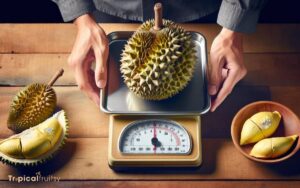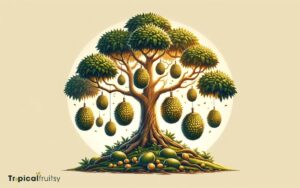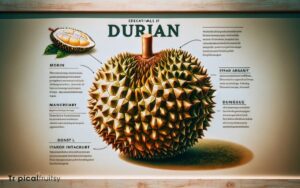Cempedak Vs Jackfruit Vs Durian: The Ultimate Showdown!
Cempedak, jackfruit, and durian are three distinct tropical fruits from Southeast Asia, each with unique characteristics.
Discover the exotic flavors and textures of cempedak, jackfruit, and durian, the unique staples of Southeast Asian cuisine.
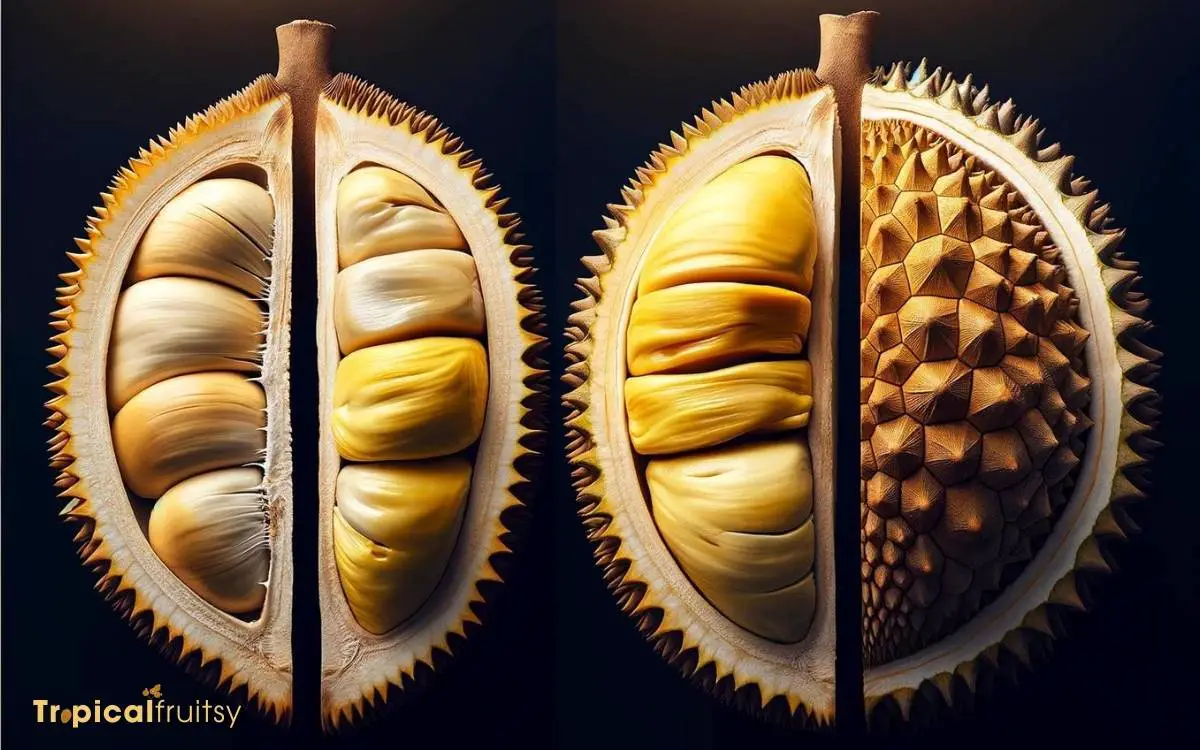
Key Takeaway
Cempedak vs Jackfruit vs Durian: A Comparison of Tropical Fruits
| Feature | Cempedak | Jackfruit | Durian |
|---|---|---|---|
| Origin | Southeast Asia | Southeast Asia | Southeast Asia |
| Size | Small | Large | Medium |
| Exterior | Spiky skin | Bumpy, hard surface | Spiky, hard shell |
| Taste | Sweet and fragrant | Sweet, versatile | Savory-sweet, complex |
| Culinary Use | Eaten raw, in desserts | Raw, cooked, desserts | Eaten raw, in pastries |
| Aroma | Mild | Sweet, fruity | Pungent, strong |
Origins and History
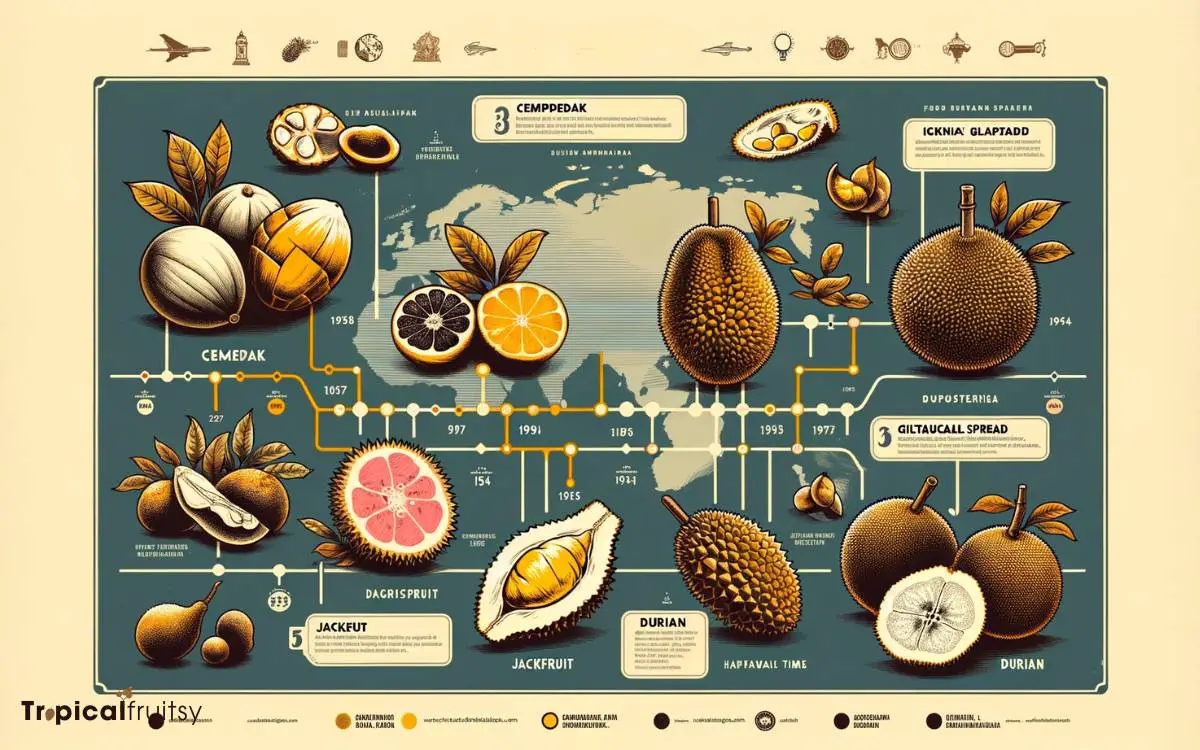
While all three fruits, cempedak, jackfruit, and durian, are native to Southeast Asia, each has a unique history of domestication and cultural significance in the region.
Cempedak (Artocarpus integer), a lesser-known relative of jackfruit, likely originated from the Malay archipelago and has been cultivated for its fibrous, sweet, and aromatic fruit.
Jackfruit (Artocarpus heterophyllus), with its massive, spiky exterior, is believed to have been first domesticated in the rainforests of the Western Ghats of India. It is now widely grown throughout tropical Asia.
Durian (Durio spp.), sometimes referred to as the ‘king of fruits’, is admired for its distinctive, potent aroma and creamy texture, with historical cultivation traceable to Borneo and Sumatra.
Each fruit embodies a profound sociocultural heritage, symbolizing fertility, prosperity, and culinary diversity across Southeast Asian societies.
Physical Characteristics
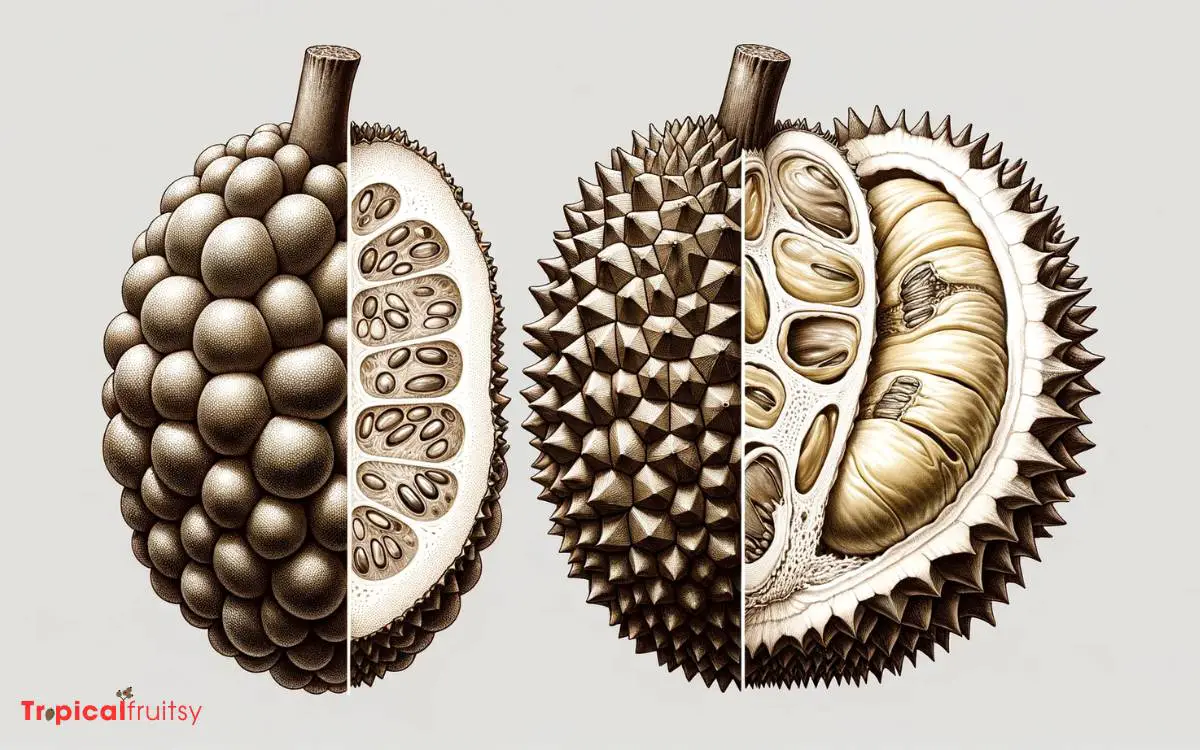
Each of these three fruits exhibits distinctive physical traits that set them apart from one another in size, texture, and color.
The cempedak is elongated and smaller than the jackfruit, typically weighing 1 to 2 kilograms, with a bumpy, yellowish-green skin.
In contrast, a mature jackfruit is massive, reaching up to 36 kilograms, with a dense, spiky exterior ranging from green to yellow-brown.
Durian, notorious for its formidable thorn-covered husk, can weigh between 1 to 3 kilograms, and its color varies from pale yellow to red, depending on the species.
These fruits also possess unique interior structures: cempedak and jackfruit contain multiple bulbous, edible arils, while durian’s flesh encapsulates its seeds within compartmentalized lobes.
Flavor Profiles Compared
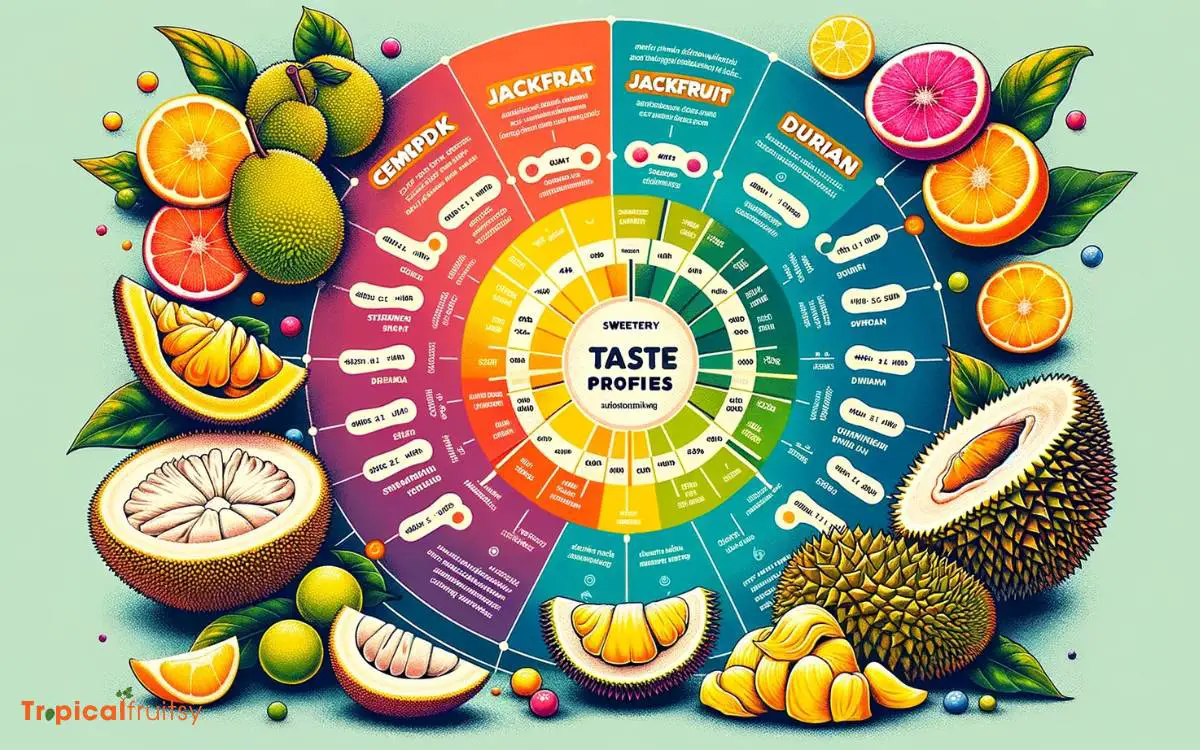
The flavor profile of cempedak is sweet and fragrant, reminiscent of a mix between banana and pineapple, while jackfruit offers a sweet, subtly tart taste with hints of apple, mango, and banana; in stark contrast, durian delivers a complex, custard-like flavor, often described as a blend of savory, sweet, and creamy notes with a pungent aroma.
| Fruit | Flavor Profile |
|---|---|
| Cempedak | Sweet, fragrant, hints of banana and pineapple |
| Jackfruit | Sweet, subtly tart, notes of apple, mango, banana |
| Durian | Complex, custard-like, savory and sweet, pungent |
These tropical fruits provide a rich tapestry of tastes that are distinct yet sometimes overlapping.
The sensory analysis reveals cempedak’s appealing tropical sweetness, jackfruit’s multifaceted flavor composition, and durian’s intense, controversial taste profile that either entices or repels consumers.
Understanding these nuances is vital for culinary applications and consumer preference anticipation.
Nutritional Benefits
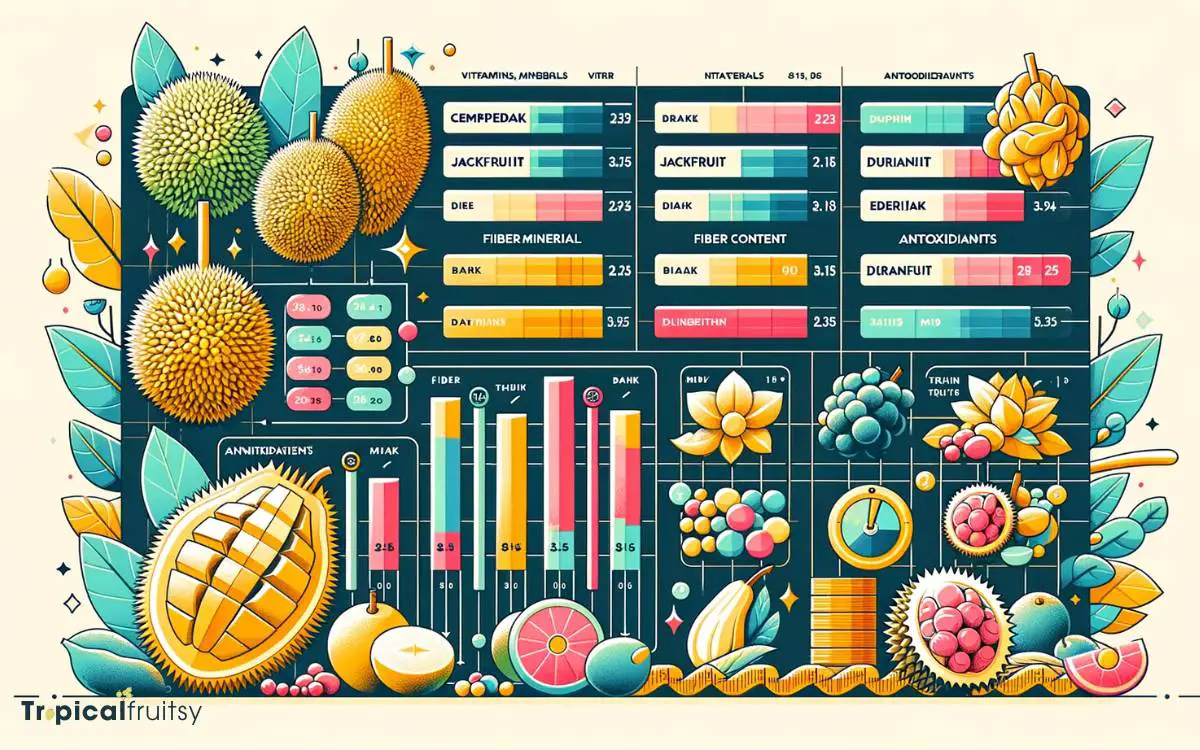
Consistently, cempedak, jackfruit, and durian not only offer unique flavor profiles but also provide a range of nutritional benefits essential for a healthy diet.
These tropical fruits are dense in vital nutrients, aligning with dietary recommendations for a balanced intake of vitamins, minerals, and fiber.
Below is a comparative overview of their nutritional contributions:
Cempedak
- High in vitamin C
- Contains dietary fiber
- Source of potassium
Jackfruit
- Rich in vitamin B6
- Offers antioxidants
- Provides protein
Durian
- Abundant in vitamin A
- High in healthy fats
- Contains thiamine and folate
Each fruit supports different aspects of health, from immune function to energy metabolism. Understanding these benefits allows consumers to incorporate them into their diets strategically.
Culinary Uses
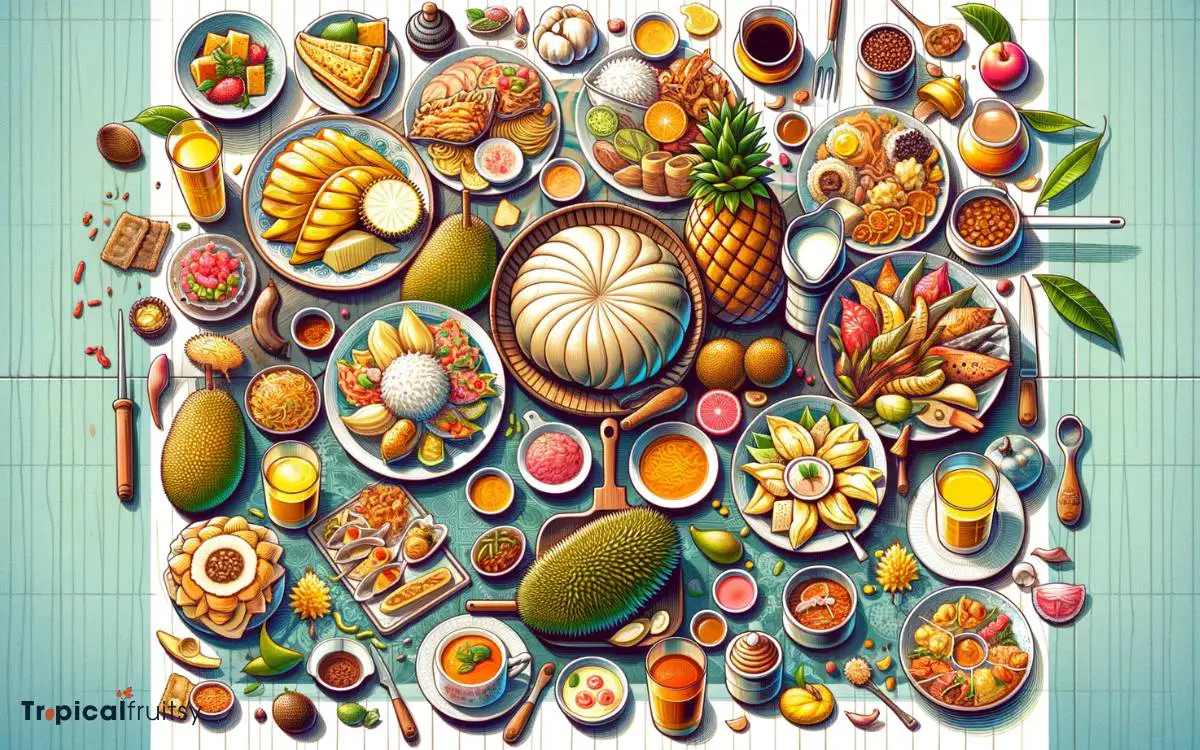
When exploring the culinary applications of cempedak, jackfruit, and durian, it is essential to consider their distinctive flavor profiles and textural properties in both dessert and savory contexts.
Cempedak is often incorporated into dessert recipes, where its sweet and fragrant pulp complements the richness of cakes, ice creams, and traditional confections.
In contrast, jackfruit’s versatility allows it to be utilized as a meat substitute in savory dishes, while durian’s potent aroma and custard-like flesh are primarily reserved for traditional Southeast Asian preparations, revered in some cultures and acquired tastes in others.
Dessert Recipes
Exploring dessert recipes reveals the unique culinary applications of cempedak, jackfruit, and durian, each imparting distinctive flavors and textures to a variety of sweet creations.
These tropical fruits are not merely supplemental; they are transformative, acting as the centerpiece in innovative gastronomic confections.
Cempedak:
- Cempedak Fritters: Batter-coated and deep-fried slices, served with a dusting of powdered sugar.
- Cempedak Cake: Pureed flesh incorporated into a batter, yielding a moist, aromatic sponge.
Jackfruit:
- Jackfruit Ice Cream: Custard-based frozen dessert with ripe fruit segments.
- Jackfruit Pudding: Silken blend of jackfruit puree and coconut milk, set with agar-agar.
Durian:
- Durian Mousse: Whipped combination of durian flesh with cream and gelatin.
- Durian Pancakes: Thin crepes filled with a rich durian cream.
Each fruit bestows a unique sensory profile, elevating traditional desserts to new heights of flavor complexity.
Savory Dish Integration
Incorporating cempedak, jackfruit, and durian into savory dishes allows chefs to experiment with bold flavors and unconventional textures in their culinary creations. Each fruit offers unique characteristics suitable for various cuisines.
The cempedak’s firm texture and sweet flavor profile can complement spicy stir-fries or curries. Jackfruit is renowned for its meat-like consistency, making it a popular substitute in vegan and vegetarian recipes such as pulled “pork” sandwiches or tacos.
Durian, with its pungent aroma and custard-like flesh, is more challenging to integrate but can add depth to sauces or creamy dishes.
| Fruit | Savory Dish Examples |
|---|---|
| Cempedak | Spicy stir-fries, Curries |
| Jackfruit | Vegan pulled “pork”, Tacos |
| Durian | Sauces, Creamy dishes |
Traditional Preparations
We observe that cempedak, jackfruit, and durian each have a storied history in traditional Southeast Asian cuisine, serving as key ingredients in a variety of regional dishes.
The culinary applications of these fruits are both diverse and indicative of their cultural significance.
Cempedak
- Fried Snack: Sliced, battered, and deep-fried to produce a crispy, golden treat.
- Traditional Cakes: Incorporated into batter for kueh or pancakes.
Jackfruit
- Ripe Fruit Consumption: Consumed raw, often as a dessert.
- Cooked in Curries: Unripe jackfruit stewed in spices, imparting a meaty texture.
Durian
- Sweet Pastes: Pureed into a creamy filling for pastries and sweets.
- Flavor Enhancer: Used in small quantities to enrich savory dishes with its potent aroma.
Each fruit’s unique texture and flavor profile are expertly manipulated in these traditional preparations to delight the palate.
Acquiring and Storing
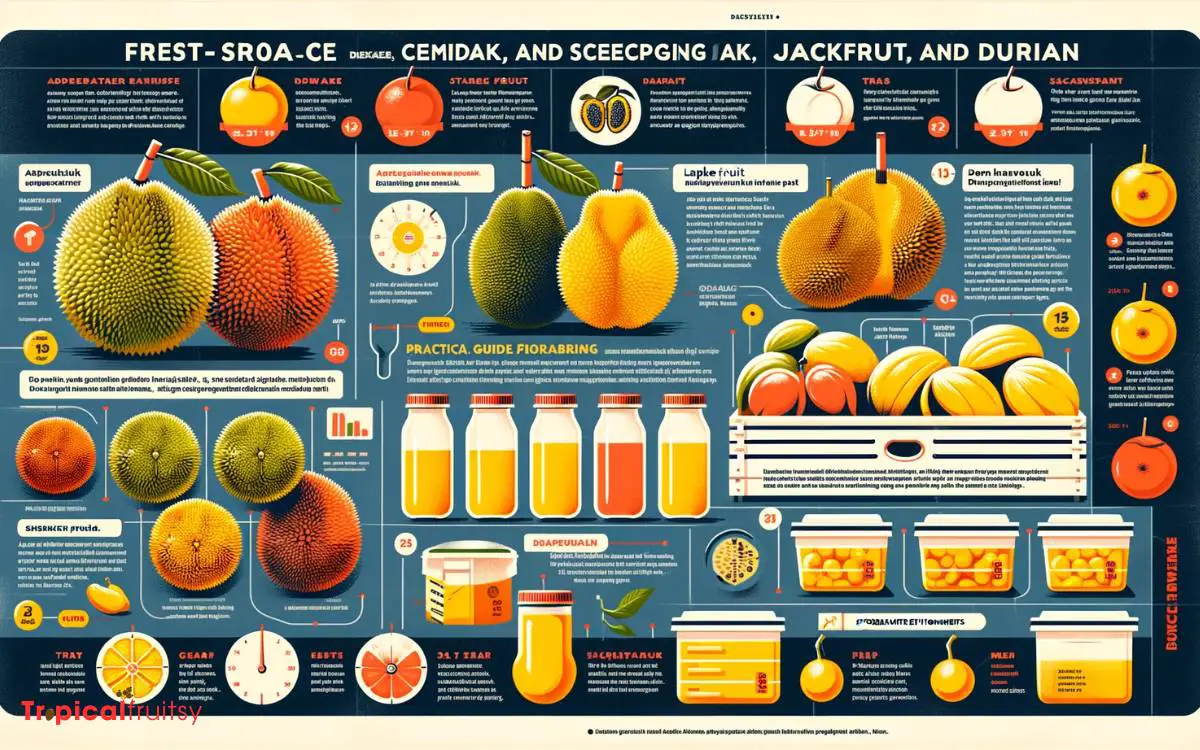
Navigating the nuances of acquiring and storing Cempedak, Jackfruit, and Durian necessitates an understanding of their respective seasonal availabilities and the subtleties of ripeness indicators.
Each fruit presents unique optimal storage conditions that are critical to preserving flavor, texture, and nutritional value.
Discerning consumers must be cognizant of these parameters to ensure the longevity and edibility of these tropical delicacies post-harvest.
Seasonal Availability
The seasonal availability of cempedak, jackfruit, and durian significantly influences their acquisition and storage methods.
These tropical fruits, each with unique harvest periods, require specialized handling to ensure freshness and quality from farm to table.
Cempedak
- Harvest: Primarily available between March and August.
- Storage: Best consumed fresh; limited shelf life necessitates rapid transportation and sale.
Jackfruit
- Harvest: Peaks from April to September, with some varieties year-round.
- Storage: Refrigeration can extend shelf life; ripe fruit is highly perishable.
Durian
- Harvest: Seasonal spikes from June to August and December to February.
- Storage: Requires careful handling due to strong aroma; can be frozen to prolong usability.
Understanding these patterns is essential for distributors and consumers aiming to optimize the procurement and consumption of these exotic fruits.
Ripeness Indicators
Several indicators can guide consumers in discerning the ripeness of cempedak, jackfruit, and durian for optimal acquisition and storage.
For cempedaks, a deepening yellow hue and a slight yield under gentle pressure indicate maturity. Additionally, a rich, sweet scent emanates from its porous skin.
Jackfruits signal their readiness through a transition to a brownish color and the emission of a distinctive fruity fragrance. The spines on the fruit also become less pronounced.
Durians’ ripeness is evidenced by a pronounced pungent aroma, a slight give at the stem, and the sound of seeds moving within when shaken.
Understanding these cues is paramount for selecting prime fruits and precedes the crucial phase of ensuring optimal storage conditions.
Optimal Storage Conditions
Upon selecting ripe cempedak, jackfruit, and durian, it is essential to consider their unique storage requirements to maintain freshness and prevent spoilage.
Each fruit has specific conditions that optimize longevity and flavor retention:
Cempedak:
- Store at room temperature until ripe.
- Once ripe, refrigerate to slow down the ripening process.
- Consume within a few days for best quality.
Jackfruit:
- Keep uncut jackfruit at room temperature in a well-ventilated area.
- Refrigerate leftover slices in an airtight container.
- Use refrigerated slices within 5–7 days.
Durian:
- Store durians in a cool, shaded area until ready to consume.
- Refrigerate in an airtight container to contain the odor and preserve texture.
- Consume within a couple of days for optimal flavor.
Conclusion
Cempedak, jackfruit, and durian are three distinct fruits, each with unique origins, physical traits, flavor nuances, nutritional profiles, and culinary applications.
While they share some similarities in appearance and usage, their differences are pronounced and influence their respective roles in cultural and gastronomic contexts.
For instance, a Southeast Asian market vividly showcases the trio’s diversity, with each fruit catering to different consumer preferences and culinary traditions. Their study reveals the rich tapestry of tropical fruit diversity.


